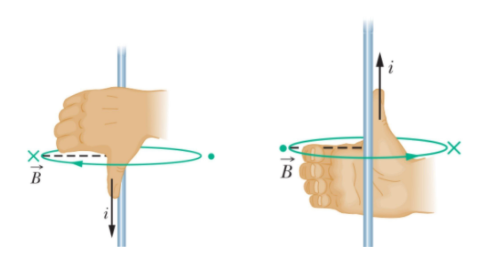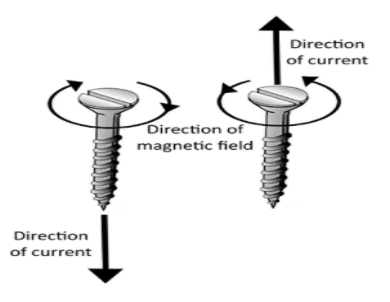
Right hand thumb rule states that
A. If we hold the current carrying conductor in right hand such that the thumb points in the direction of the flow of current, then the fingers encircle the wire in the direction opposite of the magnetic field lines
B. If we hold the current carrying conductor in right hand such that the thumb points in the direction of the flow of current, then the fingers encircle the wire in the direction of the magnetic field lines
C. If we hold the current carrying conductor in right hand such that the thumb points the magnitude of current, then the fingers encircle the wire in the magnitude of the magnetic field lines
D. If we hold the current carrying conductor in the right hand such that the thumb points in the direction of the magnetic field lines, then the fingers encircle the wire in the direction of the electric current
Answer
572.4k+ views
Hint: A current carrying conductor produces magnetic field lines around the conductor. To know the direction of magnetic lines of force or magnetic field line there is a rule called Right-hand-thumb-rule. By right-hand-thumb-rule you can see the shape of the magnetic field produced by a current carrying conductor.
Complete step-by-step answer:
In 1820, Oersted showed that a current carrying conductor produces magnetic fields around it. i.e. if you place a compass near a current carrying conductor it will show some deflection. The intensity of magnetic field at any point near a current carrying conductor can be determined by Biot-Savart’s law.
Biot-savart’s law tells that the direction of magnetic field at any point near a current carrying conductor will be perpendicular to the plane containing the conductor and the position vector of the point with respect to the wire. But if you take a straight current carrying wire which passes through a card-board perpendicularly and put some iron dust, the dust will rearrange them in concentric circles. Which shows the lines of force of the magnetic field around a wire are in the form of concentric circles. The direction of the magnetic lines of force around the wire is given by right-hand-thumb-rule.
Right hand thumb rule states that, “If you imagine holding a current carrying wire in your right-hand with your thumb pointing towards the direction of electric current flow then the direction in which your fingers curl, gives the direction of lines of force of the magnetic field”.

So the correct option is Option B.
Additional information: There is also one more rule to know the direction of magnetic field lines of a current carrying conductor. Which is Maxwell’s cork-screw rule. Which states that if a right-handed cork-screw is placed along the conductor carrying current with its axis coinciding with the direction of current , so that if the cork is twisted it travels forward in the direction of current. The direction in which the end of the handle turn gives the direction of lines of force.

Note: Note that you don’t need to actually hold the current carrying-wire to know the direction of magnetic field lines. You have to imagine that you are holding the wire to know the magnetic field. Touching a live wire is very dangerous. Also you have to point the thumb in the direction of current flow so that the curl will give the direction of magnetic field lines.
Complete step-by-step answer:
In 1820, Oersted showed that a current carrying conductor produces magnetic fields around it. i.e. if you place a compass near a current carrying conductor it will show some deflection. The intensity of magnetic field at any point near a current carrying conductor can be determined by Biot-Savart’s law.
Biot-savart’s law tells that the direction of magnetic field at any point near a current carrying conductor will be perpendicular to the plane containing the conductor and the position vector of the point with respect to the wire. But if you take a straight current carrying wire which passes through a card-board perpendicularly and put some iron dust, the dust will rearrange them in concentric circles. Which shows the lines of force of the magnetic field around a wire are in the form of concentric circles. The direction of the magnetic lines of force around the wire is given by right-hand-thumb-rule.
Right hand thumb rule states that, “If you imagine holding a current carrying wire in your right-hand with your thumb pointing towards the direction of electric current flow then the direction in which your fingers curl, gives the direction of lines of force of the magnetic field”.

So the correct option is Option B.
Additional information: There is also one more rule to know the direction of magnetic field lines of a current carrying conductor. Which is Maxwell’s cork-screw rule. Which states that if a right-handed cork-screw is placed along the conductor carrying current with its axis coinciding with the direction of current , so that if the cork is twisted it travels forward in the direction of current. The direction in which the end of the handle turn gives the direction of lines of force.

Note: Note that you don’t need to actually hold the current carrying-wire to know the direction of magnetic field lines. You have to imagine that you are holding the wire to know the magnetic field. Touching a live wire is very dangerous. Also you have to point the thumb in the direction of current flow so that the curl will give the direction of magnetic field lines.
Recently Updated Pages
Master Class 11 Economics: Engaging Questions & Answers for Success

Master Class 11 English: Engaging Questions & Answers for Success

Master Class 11 Social Science: Engaging Questions & Answers for Success

Master Class 11 Biology: Engaging Questions & Answers for Success

Class 11 Question and Answer - Your Ultimate Solutions Guide

Master Class 11 Business Studies: Engaging Questions & Answers for Success

Trending doubts
10 examples of friction in our daily life

One Metric ton is equal to kg A 10000 B 1000 C 100 class 11 physics CBSE

Difference Between Prokaryotic Cells and Eukaryotic Cells

1 Quintal is equal to a 110 kg b 10 kg c 100kg d 1000 class 11 physics CBSE

State the laws of reflection of light

Explain zero factorial class 11 maths CBSE




